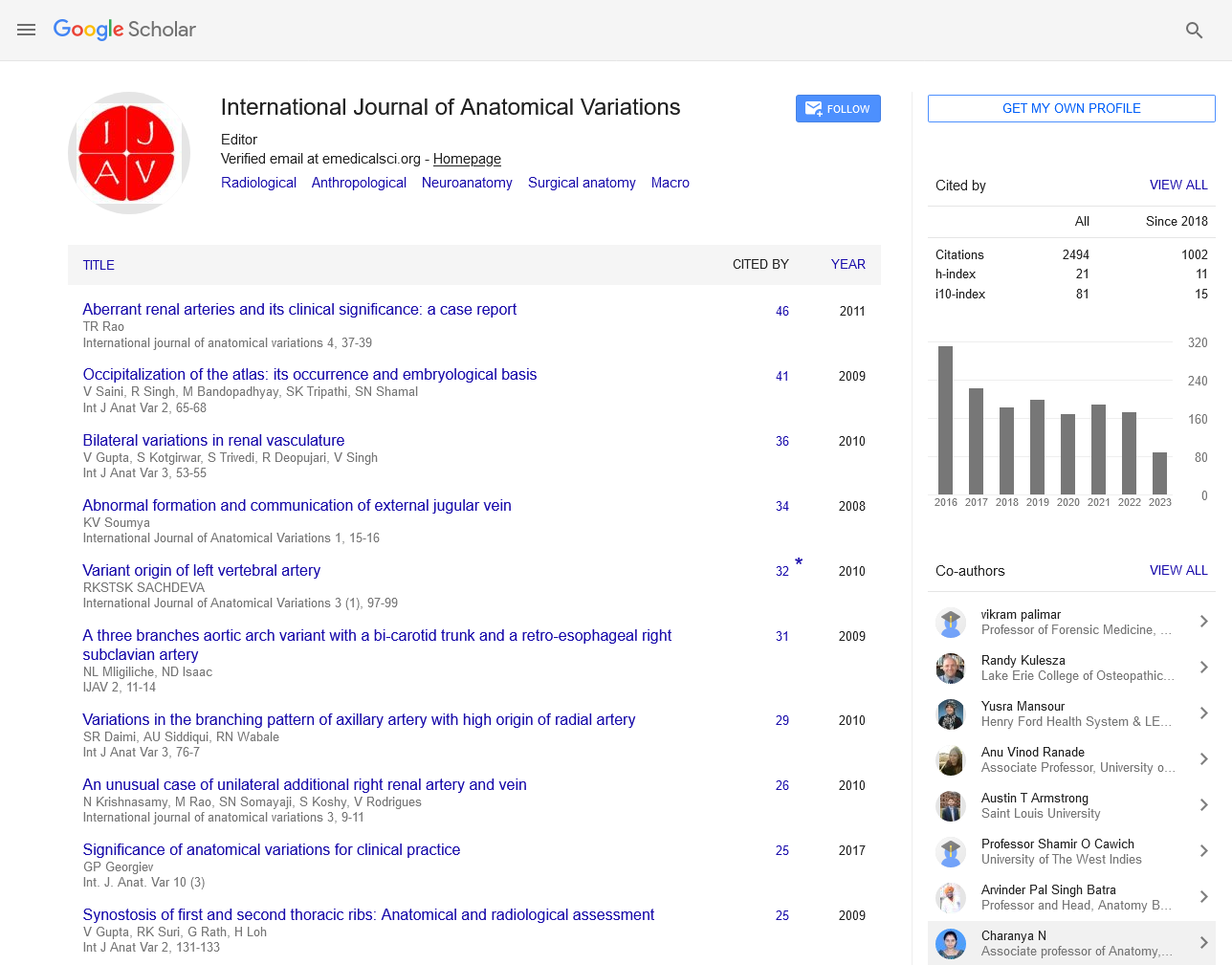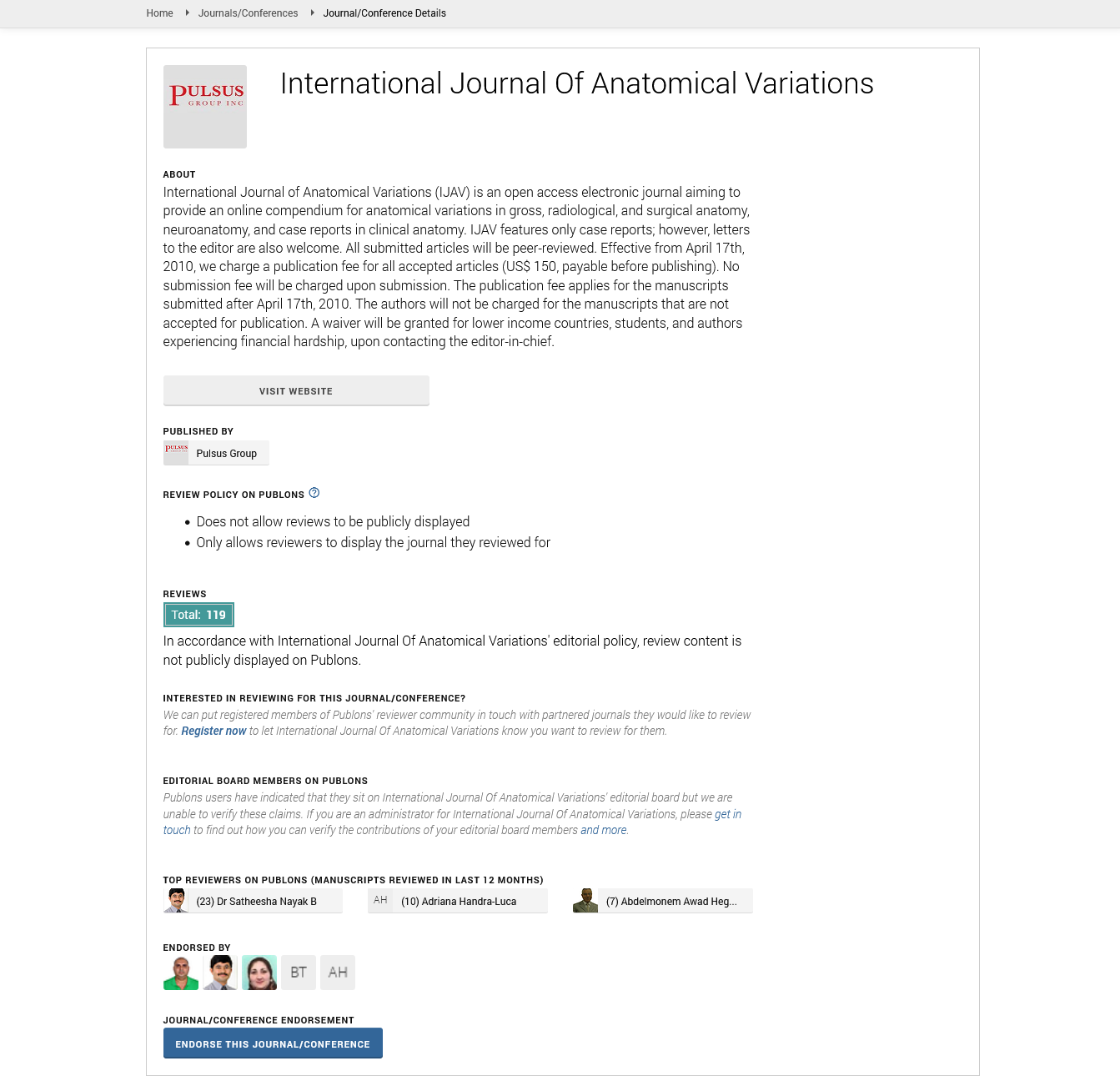Functional Anatomy of the Lymphatic System: Immunity and Fluid Balance
Received: 03-Sep-2024, Manuscript No. ijav-24-7304; Editor assigned: 05-Sep-2024, Pre QC No. ijav-24-7304; Reviewed: 19-Sep-2024 QC No. ijav-24-7304; Revised: 24-Sep-2024, Manuscript No. ijav-24-7304; Published: 30-Sep-2024, DOI: 10.37532/1308-4038.17(9).439
This open-access article is distributed under the terms of the Creative Commons Attribution Non-Commercial License (CC BY-NC) (http://creativecommons.org/licenses/by-nc/4.0/), which permits reuse, distribution and reproduction of the article, provided that the original work is properly cited and the reuse is restricted to noncommercial purposes. For commercial reuse, contact reprints@pulsus.com
Abstract
The lymphatic system plays a crucial role in maintaining fluid balance and supporting the immune response in the body. This review explores the functional anatomy of the lymphatic system, detailing its structural components, including lymphatic vessels, lymph nodes, and associated organs such as the spleen and thymus. The intricate network of lymphatic vessels facilitates the transport of lymph, a clear fluid that carries immune cells, proteins, and waste products. Lymph nodes act as filters, housing lymphocytes and macrophages that respond to pathogens and foreign substances. Additionally, the review discusses the dynamic interplay between the lymphatic system and the circulatory system, emphasizing its importance in fluid homeostasis and the prevention of edema. The contribution of the lymphatic system to immune surveillance and response is highlighted, showcasing its role in the activation and proliferation of immune cells. Understanding the functional anatomy of the lymphatic system provides insights into its significance in health and disease, with implications for developing therapeutic strategies targeting lymphatic dysfunction in various pathological conditions.
INTRODUCTION
The lymphatic system is an essential component of the human body, intricately involved in maintaining fluid balance and orchestrating immune responses. This complex network of vessels, lymph nodes, and associated organs operates parallel to the circulatory system, facilitating the movement of lymph—a clear fluid that contains immune cells, proteins, and waste products. Unlike the circulatory system, which relies on the heart to pump blood, the lymphatic system relies on a combination of smooth muscle contractions, skeletal muscle activity, and one-way valves to propel lymph throughout the body [1].
Anatomically, the lymphatic system can be divided into two main components: the lymphatic vasculature and the lymphoid tissues. The vasculature includes a vast network of lymphatic capillaries that merge into larger lymphatic vessels, eventually draining into the venous system. Along this pathway, lymph nodes serve as critical filtration points where lymph is monitored for pathogens and foreign substances. The presence of specialized immune cells within these nodes enables a swift and coordinated immune response, highlighting the lymphatic system's integral role in the body's defense mechanisms [2].
In addition to its immunological functions, the lymphatic system is vital for fluid homeostasis. It helps regulate interstitial fluid levels by collecting excess fluid from tissues and returning it to the bloodstream, thus preventing edema and maintaining optimal tissue perfusion. The interrelationship between fluid balance and immune function underscores the importance of the lymphatic system in overall health [3].
This review aims to elucidate the functional anatomy of the lymphatic system, emphasizing its dual roles in immunity and fluid balance. By exploring the structural components and physiological functions of this system, we aim to enhance our understanding of its significance in health and disease, paving the way for potential therapeutic interventions in lymphatic dysfunction and related disorders [4].
DISCUSSION
The lymphatic system serves as a pivotal interface between fluid homeostasis and immune function, reflecting a sophisticated evolutionary adaptation to maintain physiological balance while defending against pathogens. Understanding the functional anatomy of this system is crucial, as it reveals how its various components work in concert to fulfill their roles in immunity and fluid balance.
One of the primary functions of the lymphatic system is the regulation of interstitial fluid levels. The lymphatic vessels collect excess interstitial fluid, which accumulates due to the hydrostatic pressure in the capillaries exceeding the osmotic pressure of the surrounding tissues [5]. By transporting this fluid back into the bloodstream, the lymphatic system plays a critical role in preventing edema—a condition characterized by excessive accumulation of fluid in tissues. Dysfunctions in this system can lead to significant clinical consequences, such as lymphedema, which can occur due to surgical removal of lymph nodes, infections, or congenital abnormalities.
Innovative research continues to explore potential therapeutic interventions aimed at enhancing lymphatic drainage in cases of lymphedema and other conditions characterized by fluid imbalance. Techniques such as manual lymphatic drainage, compression therapy, and even surgical options like lymphaticovenous anastomosis illustrate the growing recognition of the lymphatic system's role in maintaining fluid balance [6].
The lymphatic system is equally critical for immune surveillance and response. Lymph nodes serve as hubs for immune cell activation, where dendritic cells present antigens to naïve T cells, leading to clonal expansion and differentiation [7]. This dynamic process not only facilitates a robust immune response to pathogens but also contributes to the development of immunological memory, enabling the body to respond more efficiently upon re-exposure to the same pathogen.
Moreover, the lymphatic system plays a significant role in the dissemination of cancer cells. Tumors can exploit lymphatic pathways to metastasize, raising important questions about the lymphatic system's role in cancer progression and therapy. Current research is investigating the potential for targeting lymphatic vessels to inhibit tumor spread, offering a promising avenue for cancer treatment [8].
The interdependence of fluid balance and immune function is an area of growing interest. Inflammation, for instance, can lead to increased permeability of blood vessels, resulting in fluid leakage into the interstitial space. The lymphatic system's ability to clear this excess fluid is essential for resolving inflammation and restoring homeostasis. Conversely, impaired lymphatic function can exacerbate inflammatory conditions, highlighting the importance of maintaining lymphatic health in managing chronic inflammatory diseases [9].
The functional anatomy of the lymphatic system also suggests potential links between various pathological states. Conditions such as obesity and diabetes, which are associated with altered lymphatic function, can contribute to a compromised immune response. Understanding these relationships opens up new avenues for research into lifestyle interventions and therapeutic strategies aimed at enhancing lymphatic function and, consequently, overall health [10].
CONCLUSION
The lymphatic system is a fundamental yet often underappreciated component of human physiology, intricately involved in the regulation of fluid balance and the orchestration of immune responses. Its complex functional anatomy, comprising a network of lymphatic vessels, lymph nodes, and associated organs, underscores the critical roles it plays in maintaining homeostasis and protecting the body from pathogens.
By effectively draining excess interstitial fluid and facilitating the transport of immune cells, the lymphatic system not only prevents conditions like edema but also ensures a robust immune response through the activation and proliferation of lymphocytes. The interplay between fluid balance and immunity highlights the system's dual function, emphasizing its significance in both health and disease.
Understanding the intricacies of the lymphatic system opens new avenues for therapeutic interventions, particularly in conditions marked by lymphatic dysfunction, such as lymphedema, chronic inflammation, and cancer. As research advances, there is potential to develop targeted strategies that enhance lymphatic function, improving patient outcomes and overall health.
In summary, recognizing the functional anatomy of the lymphatic system enriches our comprehension of its vital contributions to the body's intricate physiological landscape, paving the way for innovations in medical science and treatment approaches aimed at harnessing its capabilities for better health.
REFERENCES
- Vartanian AJ, Dayan SH. Complications of botulinum toxin a use in facial rejuvenation. Facial Plast Surg Clin North Am. 2005; 13(1):1-10.
- Odergren T, Hjaltason H, Kaakkola S. A double blind, randomised, parallel group study to investigate the dose equivalence of Dysport and Botox in the treatment of cervical dystonia. J Neurol Neurosurg Psychiatry. 1998; 64(1):6-12.
- Ranoux D, Gury C, Fondarai J, Mas JL et al. Respective potencies of Botox and Dysport: a double blind, randomised, crossover study in cervical dystonia. J Neurol Neurosurg Psychiatry. 2002;72(4):459-462.
- Carruthers A. Botulinum toxin type A: history and current cosmetic use in the upper face. Dis Mon. 2002; 48 (5): 299-322
- Frampton, JE, Easthope SE. Botulinum toxin A (Botox Cosmetic): a review of its use in the treatment of glabellar frown lines. American journal of clinical dermatology.2003; 4(10):709–725.
- Wang YC, Burr DH, Korthals GJ, et al. Acute toxicity of aminoglycosides antibiotics as an aid to detecting botulism. Appl Environ Microbiol. 1984; 48:951– 5.
- Lange DJ, Rubin M, Greene PE, et al. Distant effects of locally injected botulinum toxin: a double-blind study of single fiber EMG changes. Muscle Nerve. 1991; 14:672– 5.
- Wollina U, Konrad H. Managing adverse events associated with botulinum toxin type A: a focus on cosmetic procedures. Am J Clin Dermatol. 2005; 6(3):141-150.
- Klein AW. Complications and adverse reactions with the use of botulinum toxin. Semin Cutan Med Surg. 2001; 20(2):109-120.
- Eleopra R, Tugnoli V, Quatrale R, Rossetto O et al. Different types of botulinum toxin in humans. Mov Disord. 2004; 199(8):53-S59.
Indexed at, Google Scholar, Crossref
Indexed at, Google Scholar, Crossref
Indexed at, Google Scholar, Crossref
Indexed at, Google Scholar, Crossref
Indexed at, Google Scholar, Crossref
Indexed at, Google Scholar, Crossref
Indexed at, Google Scholar, Crossref
Indexed at, Google Scholar, Crossref
Indexed at, Google Scholar, Crossref






